-
Content count
137 -
Joined
-
Last visited
Posts posted by Shubin
-
-
If it is for everyone, it will not be the Internal Alchemy.
I took a quick look on some pages of the book but could not figure out his master or lineage.
-
 2
2
-
-
3 hours ago, Master Logray said:你的post並沒有討論合宗明道集,而是研究作者。 爲何不直接討論大江西派呢?
我写这篇文章就是为了研究作者的姓名,因为近半个世纪以来,很多人在这个问题上有疑问,也有弄错的,例如认为“洗心子”就是冉道源。
至于说讨论大江西派,这个话题对我来说很大,我比较喜欢讨论具体的问题。
-
On 4/6/2024 at 1:42 AM, Taoist Texts said:这有什么有趣的呢?
这部书很不错,但是在大江西派的典籍中,它可能不是最出色的,在当时也根本没挣到钱,因为从始至终(1940年代)它都是作为善书刊印的,免费赠送给好道者。所以在书里你找不到出版商和印刷商的名字,但会看到一个方形印章,里头有16个字:“此书如阅,大益身心。若不欲看,转送别人。”
比较有趣的,是编撰这部书的人和他的团队。从1940年到1944年,大约是中国抗战最艰苦的阶段。作者和他的团队,当时居住在重庆附近。日军飞机在1938到1941年中对重庆轰炸了218次,炸毁房屋1.76万幢,造成2.6万余人死伤。身处战争之中,银镜堂先生想的不是逃离,而是开门度人。他组织了同门学人和弟子,好友,以书信往来的形式开始度人,后来又从大量的书信中,选编了一些具有普遍性和针对性的问答,汇集成书,这就是《明道语录》和《明道语录续集》。而编书印书,邮寄道书和信件,以及其他相关的费用,都是由银镜堂先生个人出资。《合宗明道集》和《明道语录》,可以见证中华道家人士在战火硝烟中的坚持和奉献。
其实我在主帖里的文章,并不是文稿的全部。考虑到最后两段略微偏离了主题,就移出保存了起来。可能以后还会有用,如果有人希望把《明道语录》的作者身份也加以探讨的话。以下就是我未发表的部分。
“再来看图四里银镜堂先生写的“合宗明道集再跋 详说耑渡有缘心印”(道10-542)。此文中未提著书之事,只论耑度有缘人(此处耑同专,发音为zhuān)。并且在文末特意提示读者“早结福缘善果,以免错过此门开方便之机缘也”。有些读者会注意到图三左页下部那一幅图,[耑度有缘心印]。全书九卷但此图只有七幅,初集和中集各三幅,上集一幅。另外,处于耑度有缘四字中心的小图形似桃核,其中是两个古陶文“心印”,而且每一幅图里的这两个字,形状都略有变化。如何解读这幅心印图,在上集卷三(道10-541)开头,“铜梁后学胡燮阳”写的“合宗明道集后跋语”里有所解释。
上集里的题词之一(道10-527)是由“永春山房随缘居士”题写,请见图五左页红线处。其中有一段话值得注意:“非时非人,仙佛有不传之训。今则时不容待而知人又难,只得随缘而已。随缘者,不拘派别年龄,都因缘会以得度。” 读了前面图三和图四里银镜堂署名的题词和再跋,再读过图五左页的题词,估计当年有些读者会大喜过望,因为银先生和永春山房主人明确表示要开门度人,而且不拘派别年龄。众所周知,开门度人是一件大事,不要说是在战乱之中,即使在太平年月,度人之门大开的机缘,恐怕是百年难得一遇。”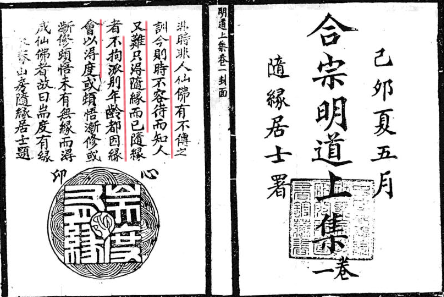
图五 (道10-527)
-
 1
1
-
-
道之出口,淡乎其无味。道书也差不多。 探讨道书的文字,也是没味儿。
-
 1
1
-
-
试析《合宗明道集》作者的姓名
(原创文章,如转载请注明出处。)
大约在上世纪中叶,《合宗明道集》由真善美出版社再版刊印,后又被数家出版社将此书与《明道语录》合刊出版。封面上的作者署名,有写“冉道源”的也有写“银道源”的。本文试图从《合宗明道集》一书的内容入手,探讨作者的真实姓名。
从网上见到的照片来看,各出版社所用的底本,应该是来自初版于“己卯夏五月”(1939年农历五月)的,民国二十八年石印本。对比《中国宗教历史文献集成》(黄山书社2005年出版)一书第二编《三洞拾遗》中所收的《合宗明道集》,发现该书影印时所用的就是这个民国刊本。目前此影印本有免费电子版可直接阅读[1],也有rar文件可以下载[2]。由于电子版《合宗明道集》是从民国刊本影印而来,大家又都可以看到,那么下面的讨论就围绕此本进行。以下凡是提到页码的,都是指影印本《合宗明道集》的页面底部正中的页码。需要说明的是,影印本每一页含民国刊本四面。例如原书卷一的封面,题词和目录两面,在影印本中都是在页码为(道10-495)的这一页里。
先来看图一,编校者页。图中的红色横线是笔者后加上去的,以便于比较该页内诸位人士之间的关系。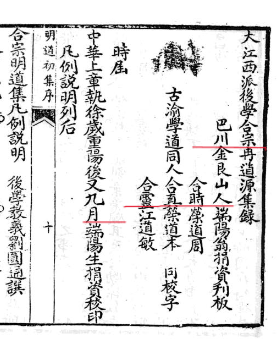
图一 (道10-500)
右边第一列,"大江西派后学合宗冉道源集录",顶格书写,中规中矩。可知此书的编篡者姓冉,与大江西派有关,“合宗”和“道源”或为道号。用“集录”而不用“撰”或“著”,可见编篡者的谦虚与低调。“后学”指后进的学者或读书人,在此应为自谦之语。
第二列里,“金艮山人”四个字颇为引人注目。艮为山,“金艮”不就是金山么? 自称“端阳翁”,或许是一位富贵老者,而且他与此页内其他几位有些渊源。大多数清末和民国的书籍,是把编著者的名字放在封面或卷首,捐资者的名字放在书末或封三。一般说来,捐资者或对善书的内容知之不多,或者与编著者素不相识,或持不同的志趣,甚至是生活在不同的年代。此处的“金”字与右边的“冉”字同高,“端”字与左边的“荣”字同高,可见这位富贵老者或许是古渝学道同人之一,而且资历不逊于页内左边四人。如果“端阳翁”是学道同人,他在此处用“金艮山人”这个别号,估计不是为了炫富,很有可能是在暗示他的名字与“银”字有关。因为“金”和“艮”二字横着连写就是个“银”字。
再看第三,四,五列。此三人名号里都有“合”字与“道”字。可见冉姓荣姓江姓共四人,以及本书初集第一序(道10-498)的撰写者“合天周道成”,和本文后面提到的“合中黄道堃”(道10-556),这六人可能具有大江西派“道”字辈身份,同时还具有龙门派“合”字辈身份。第七列的“端阳生”应该是资历较浅者,在他的名号之上给安排了13个字,就把整列都占满了,与最右边的第一列有遥相呼应之势。“上章”相当于“庚”,“执徐”相当于“辰”。如果用农历的写法,庚辰年重阳后又九月,就是“辛巳夏六月”,即民国三十年(1941年)六月。这里放上以“中华”二字开头的13个字,从版面看是使“端阳生”处在比右边四人低一字的位置上。从文字的内容来看,彰显了中华太岁纪年法和古渝学道同人的爱国情怀,因为当时的大环境是中国抗战进入了最艰苦阶段。本书初集第二序(道10-499页)的撰写者“教礼刘明通”在序中写下:“...吾合宗道源师...复念丁斯浩劫,生灵涂炭,敌国外患,糜烂无以加矣!而战云迷漫世界,危如一发千钧。知外道旁门之教义,实不能济此末世之倾危,舍斯道其何以纲维全宇,救人类之灭绝耶?因是乃循门人之请求,录出旧日撰述,选印九卷,名曰《合宗明道集》。” 这一段讲的很清楚,是在门人提出请求之后,“合宗道源师”把自己以前撰述的文字选录出九卷,编篡成《合宗明道集》。
下面看本书的中集。这里要说明一下,《合宗明道集》全书共三集每集三卷,但只有中集有自己的名字:[玉京法程] 。先看合中黄道堃写的“玉京法程序”,因为其中提到了一位“端阳老先生”。
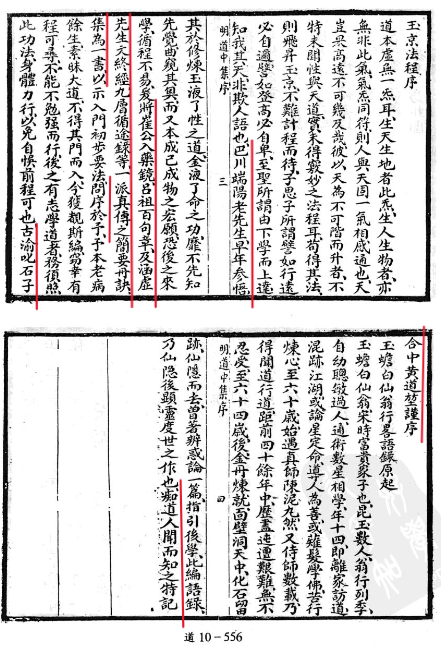
图二
请看图二上部右页末列红线处“巴川......”二字,至左页第五列的“问序於子”这一段。把这段内容简化一下以便于理解:“巴川端阳老先生...... 集为一书...... 问序於子”。如果把这一段与上面刘序的末句联系起来看,就可以做一个推理:既然此书(玉京法程)是由“端阳老先生”所集,那么他与刘序里讲的“录出旧日撰述,选印九卷"的“合宗道源师”应该是同一人。只是由于刘,黄二人的身份不同,所以他们对冉道源的称呼不同。在此还可以做一个推测:按年龄看,“端阳老先生”应该是指编校者页上的“端阳翁”,而不是资历较浅的“端阳生”。在本书上集“及门教一子”写的序(道10-528)里提到了“合宗道源师”的年龄。把这一段抄录过来:“......合宗老人,巴川之隐君子也。性既孝友,酷嗜于道。三教经传,百氏典籍,靡不精研实证。年逾稀龄,貌似壮强。慨大道之不明也久矣。翻刻各种善书而外,复将生平心得于修己立人之学,辑为一书。颜曰《合宗明道集》......"。可见此时(1939年)“合宗道源师”已经70多岁了。
在中集的“玉京法程序”之前,是“玉京法程绪言”(道10-555)。为节省篇幅只把要点抄录过来:“兹有二三道侣...... 体验仙师法程...... 同参各种丹经...... 特选崔公、吕祖、涵虚一派真传之简要次序丹诀...... 集为一书...... 刊板印刷。俾有志学仙者...... 真参实悟...是则集书者之区区微意也夫。痴道人识" 。这一篇又提到了“集为一书”还有“刊板印刷”。这位集书刊板的人是谁呢?自然是指"二三道侣", 其中就有此文落款里的“痴道人”。
在本书中落款为“痴道人”的文章还有三篇,其一是图二下部的“玉蟾白仙翁行略语录原起”。其二是“崔公入药镜三字经浅解序”(道10-570)。其三是“吕祖百句章白话说明”(道10-575)。现将第三篇文中关于“痴道人”的部分抄录如下:“痴泛览群书,虚劳岁月,已历六十春秋,幸蒙涵虚先生,暗里提携得受《三车秘旨》,参悟《九层炼心》,略识丹道层次。今因未得《百句》真解,聊作一解,......幸甚幸甚! 痴道人记”。可见“痴道人”遇李涵虚先生是在60岁之后。那么再做个推理,因为“痴道人”集录刊印《合宗明道集》,那么他与“合宗道源师”是同一人,与端阳翁也是同一人。
中集卷二的封面比较重要,因为里面出现了两个名号:“银镜堂”和“镜堂银公铨”。请见图三中红线处。另外,本书上集卷三里的后跋之二,落款是“银公铨镜堂题”,请见图四左页末列红线处。
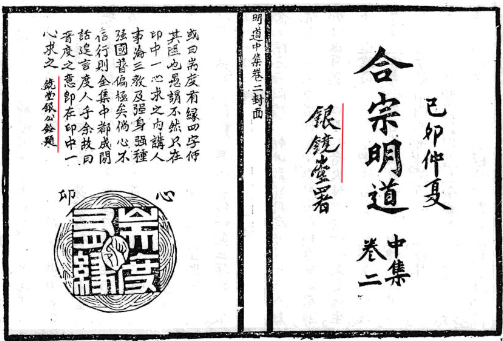
图三 (道10-563)
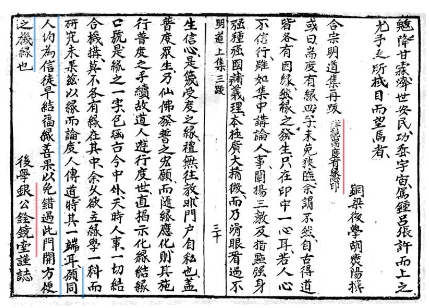
图四(道10-542)
前面曾讲过,学道之人在书中用“金艮山人”的别号,可能是想暗示他的名字与“银”字有关。图三和图四里的银镜堂和银公铨,名字中都有个“银”字,可见“金艮”二字确实是有所指。那么他的名字是“银镜堂”还是“银公铨”呢?。考虑到这三处落款的情形有所不同,重点看图四里左页“合宗明道集再跋”的落款,“后学银公铨镜堂谨志”。
古人在著述末尾处落款里的自称,大约从汉代起形成了一个固定的格式,即名在前,字在后,而且一直为后世所遵从[3]。依此论之,“银”是姓,“公铨”是名,“镜堂”是字。中华传统文化里命名取字都有学问,名与字有固定的组合方式,所以能“闻名即知其字”。铨,衡也。考量以铨。公,平分也。公之为言公正无私也。“镜堂”二字可能出自典故“虚堂悬镜”[4]。因“铨”可称重,“镜”可察形,有审度、鉴察之功能,此二物属于连类相及。故以“公铨”为名“镜堂”为字,是符合名与字的组合方式的。从古人常用的字辈看,“公”是一个常用字。例如明朝初年朱元璋曾赐孔氏八个辈字,“公、彦、承、弘、闻、贞、尚、胤”[5]。 历史名人以“镜堂”为字的,有清代人牛鉴(字 镜堂 ),嘉庆十九年进士[6]。
至此做个推测:“金艮山人”端阳翁本人姓银,名公铨,字镜堂,别号之一是“痴道人”。为什么银先生要在《合宗明道集》里把自己的真实姓名隐去呢?估计是想避免为声名所累。为什么要改成姓“冉”呢?可能是因为重庆有些区县(例如丰都)的方言,在发音上“圆”与“云”不分,还有,“盐”与“银”不分[7]。另外,冉姓人口比银姓要多,据2020排名,前者是第198名,后者是第289名。
甲辰季春后学蜀宾述于美东巴城之郊
-------------------------------------------------------------------------
[1] https://www.taolibrary.com/category/category76/c76041.htm#
[2] http://www.homeinmists.com/new_uploaded.htm
[3]《中国人的名字别号》 吉常宏著,商务印书馆1997年版 https://www.99csw.com/book/4807/171488.htm
[4]《宋史·陈良翰传》:“无术,第公此心,如虚堂悬镜耳。” https://www.zdic.net/hans/虚堂悬镜
[5] 孔氏家谱的流变 http://www.kongjia.org/web/ah/20240127/2007.html
[6]《中国历代人名大辞典》 牛鉴,清甘肃武威人,字镜堂。嘉庆十九年进士。授编修。累官至两江总督。
[7] 重庆区县方言大测试 https://www.163.com/dy/article/DR49K5QO0518W8E1.html-
 1
1
-
-
I translated my short article into English with DeepL and Papago, it turned out that DeepL did a better job on some paragraphs, and Papago did a better job on the other.
Talking about the palace color book "Jindan Album" (Christie's Paris 7/6/2022)
An article in The Value Art Magazine said on July 6 that Christie's in Paris "just sold a copy of the Qing Dynasty's alchemy in France. "The 48-page booklet is rich in pictures and text, and features articles on alchemy and related hexagrams, as well as elaborate refining processes and colorful portraits of immortals.
So rare in the art market, such a successful successful auction, 终600,000, 60 times the value of 60600,000, including $756,000 ($HK$6 million; NT$22.6 million), won the Paris Christie's "Asia Art" auction.
(Link to The Value article in English) (Link to The Value article in Chinese)
As soon as this book appeared, it attracted the attention of the Chinese cultivation community, because it was indeed unprecedented. Someone posted on WeChat, suggesting 2 points. First, there is a picture of Zhu Jian-shen, the Emperor Xianzong of the Ming Dynasty, and secondly, this picture book belongs to the Ming Dynasty.
Christie's in Paris described the album as:
Lot 71 Colored Silk Coloring Book Page 48
Size: 24.5 x 22.5 cm
Source: French collector R.J.S. Collection
Valuation: 1010, 000 - 15, 000
According to an article on The Value website, "Among the Qing emperors, Yongzheng was the most devoted to Taoism. According to Qing documents, he placed Taoist talismans in the main palaces, including the Taihe Hall and the Qianqing Palace; he set up a dou altar in the Yangxin Hall of his dormitory; he built a house in the imperial garden for Taoist priests to live in; and he ordered vestments in Suzhou. At the same time, Yongzheng even secretly ordered his ministers to look for hermits and good healers to build a furnace in Yuanmingyuan to make pills for him to take. "
It is estimated that Christie's Paris will not use above paragraph to identify the album as a Qing Dynasty relic, but will ask the experts to identify it.
I looked at the photographs in the article, but judging by the clothes of the characters in the paintings, I think they are not Ching Dynasty clothes. In addition, the text in 2 of the photos, there are two places where the word "Xuan" is not taboo. That is, in "Taihe Zhiyi Jindan Tu", the fifth column from the left, the second character from the bottom, and in "Jindan Lun", the second column from the left, the eighth character from the bottom. The Qing dynasty from the Kangxi dynasty that is taboo "Xuan" word, so this album is not the Qing dynasty, and can not be related to Yongzheng, because the Shunzhi, Kangxi, Yongzheng, Qianlong four dynasties text avoidance is extremely strict, the number of text prison, the scale of the large, extensive involvement, the killing of the bloody, are said to be unprecedented.
Is the man in the picture wearing a gauze hat Zhu Jianshen? I think it's difficult to determine just by comparing it with the portrait of Emperor Xianzong of the Ming Dynasty.However, the man in the painting wearing a gauze hat wearing bright yellow clothes, estimated to be the emperor. If you look closely at the hair inside the hat, you can see that it is black from the forehead to the top of the head, so this man is not "the Manchu people".
In addition, there is a picture of three people, sitting in the middle, should be the Taishang Laojun (moral god) because he has three stripes on his forehead, and his hair is all white.
There should be no inscription or seal or title in this album. There are four small characters on the cover of the book " Jindan Atlas", under which it is written "45 open". Because it is not written with a brush, it is not believed to have been written by the original author. -
I am not the only one or the first one who think so. I wrote a short article about it.
-
 2
2
-
-
Actually it is not a Qing dynasty's royal secret manual but Ming dynasty's. Ming is the dynasty just before Qing, so the manual is about two hundreds years early than Christie’s description and is more valuable.
-
 1
1
-
-
"On 6 July (2022), Christie’s presented an Art d’Asie Sale in Paris, featuring a wide array of Asian art – from imperial porcelains to Tibetan thangka. Surprisingly, it was a Taoist alchemy album from early Qing dynasty (1644-1911) which achieved the highest price and stole the show.
The 48-page Taoist alchemy album – illustrated with colourful pictures, diagrams and detailed essays – is an ancient Chinese guide to produce a Golden Elixir for immortality." --- By: Kayan Wong@THE VALUE
The link to the articleThe link to the article (Chinese version)
-
 2
2
-
 1
1
-
-
On 3/15/2022 at 9:05 AM, awaken said:- 我不是教自發功的老師,我是教丹道的老師,我認為自發功自己練就好,但是總會遇到一些笨蛋,太看輕自發功,練了之後,又害怕自發功的氣太強,然後就開始用一些江湖術士騙子學來的方法去壓制自發功的氣,因此造成身體的不適
古代丹经里没有讲自发功的。你知道为啥不讲么?自发功是从哪一年开始流行的,你知道么?
你并不懂丹道,却自认为是教丹道的老师,四禅八定是道家的功夫么?
No ancient Daoism books mentioned any spontaneous gong。Do you know why?
In which year spontaneous gong was getting popular?Do you the answer?
You know a little about Daoism, but believed that you can teach others.
The four dhyanas and eight samadhis are belong to Daoism or Buddhism?
-
 1
1
-
12 hours ago, awaken said:丹道的來源是來自於古埃及,古埃及就是夏朝。
The source of Dan Dao comes from ancient Egypt, which is the Xia Dynasty.
You are making some people laugh, and some cry.
-
There was no lions in ancient China, but there were tigers, and many unearthed cultural relics are found.
For example, https://m.thepaper.cn/rss_newsDetail_16479829?from=
and https://news.artron.net/20201222/n1046543.html
and https://www.360kuai.com/pc/920414a03fbd9eba7?cota=3&kuai_so=1&sign=360_7bc3b157
-
It looks like that you might not understand this poem, or you did not take a look on your translation.
In this poem, 周天 is about cycles, not a week or 7 days.
十月 is (taking at least) 10 mouths, not October.
運周天水火,
Water and fire are transported in the week,
十月脫胎丹就,
In October, the birth of the womb is completed,
-
It seems for me that DAO BUMS is not so good and not bad, too, but I do not understand why "道家学说" was put there, under "Discussions On the Way", because I could not find a direct connection between them.
From my point of view, our website has all kinds of discussions and Daoism discussions might not be a significant part. Are there some stories behind the four characters, 道家学说?
-
6 hours ago, awaken said:該我問你問題了。
請問你到底要不要練?
It's time for me to ask you a question.
Do you want to practice?
Sorry, I do not want to practice your Wuwei Dandao, but thanks for taking time answering my questions.
Hope you have good luck!
-
 1
1
-
-
Thanks for answering my questions.
It looks like that you invented "Wuwei Dandao" by yourself,so it is a new method, not something inherited.
After studied《悟真篇》and《參同契》, you believed that you are able to understand these two books very well.
You also believe that your "Wuwei Dandao" matches these two books perfectly.
In China for more than 1,000 years, people wrote many annotation books or explanatory notes of 《悟真篇》and《參同契》, because they were unable to understand them, so they could not practice methods in the two books because they did not have a chance to learn the methods face to face from a master who had an authentic inheritance.
If someone does not know the secret of cultivating golden elixir, and has no inheritance at all, how she/he is able to teach others?
It seems for me that you need to write annotation books about《悟真篇》and《參同契》, and decrypt all metaphors in the two books. It would be a huge contribution to the world. People will come to you and follow you, and I might be one of the followers.
-
10 hours ago, awaken said:關於我的個人經歷,已經有張貼出來了,麻煩您自己看一下,謝謝
Regarding my personal experience, it has already been posted, please take a look at it for yourself, thank you
不過我勸你不要太相信所謂的傳承,很多都是造假的,QQ上面的很多中國人都知道這件事情
But I advise you not to believe too much in the so-called inheritance. Many of them are fake. Many Chinese people on QQ know this.
如果你指的是搬運法的傳承,我是完全沒學過搬運法,也不想學那套搬運法,所以我完全沒有搬運法的傳承
If you are referring to the inheritance of the handling method, I have never learned the handling method at all, and I do not want to learn that set of handling methods, so I have no inheritance of the handling method at all.
Thanks for trying to answer my questions.
If you're talking about this resume, Posted April 1,
"三十歲的時候,我跟佛教密宗大師學習本尊法。
三十五歲的時候,在最後一次參加南傳葛印卡的七日禪修之後,我決定捨棄所有的有為法。我開始修煉無為法。就從自發功下手。"
I could not find a clue about your master of Wuwei Dandao, so I asked those two questions.
-
When you get a chance, could you please tell us something about your master of Wuwei Dandao?
How many years you followed this master? Thanks.
-
谢谢您的详细解释。
养气 ,其法是忘形以养气。但忘形是人的自然状态么?在我看来不是。无论是今人还是古人,一个未开悟的普通人不会忘记自己的形,所以他们都一直耗气。忘言也不是人的自然状态。
Thanks for your detailed explanation.
”nourish qi“ or cultivating qi --- the method is by forgetting one's body. Is it a natural status of an ordinary person that he keeps forgetting the body of herself? I do not think so. Ordinary people, as long as they have not awoken, they will not forget their bodies, so they always consuming qi of themselves.
Forgetting words or native language is not the natural status of ordinary people.
-
养气,忘言,降心,都是有为吧?
-
Come on, it is Leakless, not leaking.
-
2 hours ago, awaken said:你在漏盡閣裡面?
那你就不應該問我這個問題,你應該知道怎麼回事。
如果你不知道,那我告訴你,漏盡閣因為系統重置,造成帳號出問題,一堆人帳號登不進去,我就是其中一個。
所以我只能看到沒帳號的內容。
看看就拿來轉貼,如此而已。
Are you in the leaky pavilion?
Then you shouldn't ask me this question, you should know what's going on.
If you don't know, then let me tell you, due to the system reset, the account of the leaking house has problems, and a bunch of people can't log in to their accounts, and I am one of them.
So I can only see content without an account.
Take a look and repost, that's all.
很多人都是注册一个新账号,之后再看是否要恢复原来的账号。
如果你想找回原来的账号,我也可以帮你联系版主,看看能否有可能重置或解封。
-
五步真气运行法,I would translate it to "The five-steps of genuine Qi movement“.
However, it is not a method of Nei dan shu. It is a qigong among hundreds qigongs, and it is not popular any more in China for many years.
漏盡閣 has nothing to do with a “leaking house”. It is a website of discussing Nei dan shu and Dao related topics.
漏盡 means "leakingless ", and 閣 is a building (pavilion).
There are hundreds of interesting and important topics posted in 漏盡閣 every year, so I do not understand why you picked a 10 years old boring topic.
-
 1
1
-
 1
1
-
-

Kunlun Xian Zong Pai by Liu Peizhong in Taiwan
in Systems and Teachers of
Posted
I did not know there is a Kunlun Xian Zong Pai (崑崙仙宗), at lease in mainland of China。
Their website has a lineage but it did mention anything about Wu-Liu School.